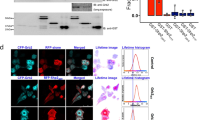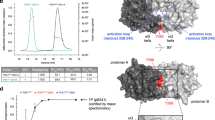Abstract
THE enzymes p70s6k and p85s6k are two isoforms of the same kinase1,2 and are important in mitogenesis2–4. Both isoforms are activated by a complex phosphorylation event5 and lie on a common signalling pathway4, distinct from that of the p42mapk/ p44mapk kinases6 Activation of P42mapkp44mapk is triggered by sequential activation of the GDP– GTP exchange factor Sos, the GTP-binding protein p21ras, and protein kinases p74rafand p47mek (refs 7–10). As p21ras transformed cells have increased S6 phosphorylation11, we tested whether the p70s6k/p85s6k signalling pathway bifurcates between p21ras and P42mapk/p44mapk. We found that mutants of p74raf and p2ras blocked activation of epitope-tagged p44mapk but not epitope-tagged p70s6k. Moreover, in cells expressing human platelet-derived growth factor receptors lacking the kinase-insert domain, the growth factor activates p21ras but not p70s6k/p85s6k. The critical autophosphorylation site for p70s6k/ p85s6k activation within this domain is a tyrosine at residue 751. Our results show that the p70s6k/p85s6k signalling pathway is independent of p21ras, that it bifurcates from the p2lras pathway at the receptor, and that it is initiated by autophosphorylation at a specific site.
This is a preview of subscription content, access via your institution
Access options
Subscribe to this journal
Receive 51 print issues and online access
$199.00 per year
only $3.90 per issue
Buy this article
- Purchase on Springer Link
- Instant access to full article PDF
Prices may be subject to local taxes which are calculated during checkout
Similar content being viewed by others
References
Kozma, S. C. & Thomas, G. in The Protein Kinase Facts Book (eds Hardie, D. G. & Hanks, S.) (in the press).
Reinhard, C. et al. EMBO J. 13, 1557–1565 (1994).
Lane, H. A. et al. Nature 363, 170–172 (1993).
Chung, J. et al. Cell 69, 1227–1236 (1992).
Ferrari, S. et al. J. biol. Chem. 268, 16091–16094 (1993).
Ballou, L. M., Luther, H. & Thomas, G. Nature 349, 348–350 (1991).
Feig, L. A. Science 260, 767–768 (1993).
Crews, C. M. & Erikson, R. L. Cell 74, 215–217 (1993).
Pelech, S. L. Curr. Biol. 3, 513–515 (1993).
Egan, S. E. & Weinberg, R. A. Nature 365, 781–782 (1993).
Blenis, J. & Erikson, R. L. J. Virol. 50, 966–969 (1984).
Egan, S. E. et al. Nature 363, 45–51 (1993).
Schaap, D. et al. J. biol. Chem. 268, 20232–20236 (1993).
Kolodziej, P. A. & Young, R. A. Meth. Enzym. 194, 508–519 (1991).
Wood, K. W. et al. Cell 68, 1041–1050 (1992).
Feig, L. A. & Cooper, G. M. Molec. cell. Biol. 8, 3235–3243 (1988).
Kolch, W. et al. Nature 364, 249–252 (1993).
de Vries-Smits, A. M. M. et al. Nature 357, 602–604 (1992).
Westermark, B. et al. Proc. natn. Acad. Sci. U.S.A. 87, 128–132 (1990).
Fantl, W. J. et al. Cell 69, 413–423 (1992).
Burgering, B. M. Th. et al. Cell Growth Diff. 5, 1–7 (1994).
Arvidsson, A. K. et al. Molec. cell. Biol. (in the press).
Kazlauskas, A. et al. Molec. cell. Biol. 12, 2534–2544 (1992).
Nishimura, R. et al. Molec. cell. Biol. 13, 6889–6896 (1993).
Chung, J. et al. Nature 370, 71–75 (1994).
Rodriguez-Viciana, P. et al. Nature 370, 527–532 (1994).
Lane, H. A. et al. EMBO J. 11, 1743–1749 (1992).
Boulton, T. G. et al. Science 249, 64–67 (1990).
Meloche, S., Pagès, G. & Pouysségur, J. Molec. Biol. Cell 3, 63–71 (1992).
Wennström, S. et al. Oncogene 9, 651–660 (1994).
Author information
Authors and Affiliations
Rights and permissions
About this article
Cite this article
Ming, XF., Burgering, B., Wennstrom, S. et al. Activation of p70/p85 S6 kinase by a pathway independent of p21fi ras. Nature 371, 426–429 (1994). https://doi.org/10.1038/371426a0
Received:
Accepted:
Issue Date:
DOI: https://doi.org/10.1038/371426a0
This article is cited by
-
Phosphorylation of TSC2 by PKC-δ reveals a novel signaling pathway that couples protein synthesis to mTORC1 activity
Molecular and Cellular Biochemistry (2019)
-
Decreased activation of placental mTOR family members is associated with the induction of intrauterine growth restriction by secondhand smoke in the mouse
Cell and Tissue Research (2017)
-
Inhibition of S6K1 accounts partially for the anti-inflammatory effects of the arginase inhibitor L-norvaline
BMC Cardiovascular Disorders (2009)
-
A brief introduction to FOXOlogy
Oncogene (2008)
-
S6K1
AfCS-Nature Molecule Pages (2008)
Comments
By submitting a comment you agree to abide by our Terms and Community Guidelines. If you find something abusive or that does not comply with our terms or guidelines please flag it as inappropriate.



